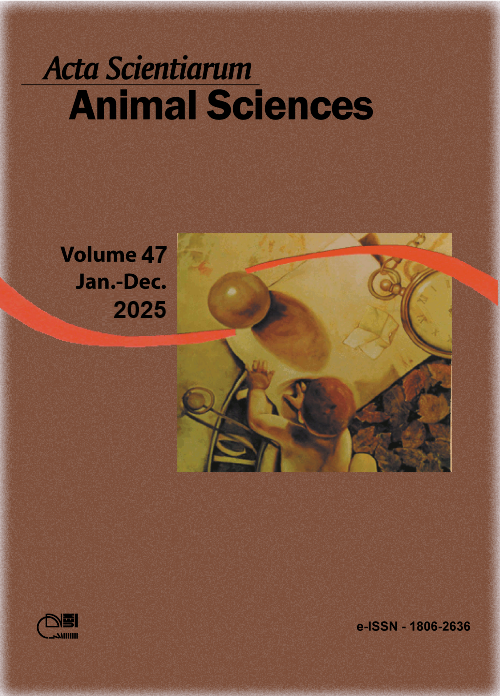Using the five domains to assess the well-being of equines in the municipality of Juatuba – state of Minas Gerais
Resumo
Due to the growth of horse breeding in Minas Gerais, there has been an increase in the number of horses kept in individual stalls, which compromises their health and favors the appearance of stereotypies, as horses are highly influenced by environmental conditions. In order to assess and minimize the effects of confinement, an analysis form was drawn up based on the Five Domains model and the Animal Welfare Assessment (AWA) practical guide. The aim of the study was to evaluate and quantify the EW status of 12 farms in the city of Juatuba, in the metropolitan region of Belo Horizonte, Minas Gerais. The data was analyzed by analysis of variance, using the FREQ procedure of SAS, version 9.0 (SAS Inst. Inc., Cary, NC, USA). The Welfare Assessment Form made it possible to identify which aspects within the Five Domains could be improved to ensure a better quality of life for the animals. The properties evaluated had a satisfactory Welfare status in general, but some specific characteristics require adjustments to meet the criteria mentioned.
Downloads
Referências
Broom, D. M., & Molento, C. F. M. (2004). Bem-estar animal: Conceito e Questões relacionadas revisão. Archives of veterinary Science, 9(2). https://doi.org/10.5380/avs.v9i2.4057
Cintra, A. G. C. (2014). O cavalo: Características, manejo e alimentação (1ª ed.). Roca.
Leme, D. P., Silva, E. L. D., Vieira, M. C., & Buss, L. P. (2017). Manual de boas-práticas de manejo em equideocultura. Ministério da Agricultura, Pecuária e Abastecimento, Secretaria de Mobilidade Social, do Produtor Rural e Cooperativismo. MAPA/ACE/CGCS.
Lofgren, E. A., Rice, B. M. G., & Brady, C. M. (2020). Exploring perceptions of equine welfare scenarios using a positive approach. Journal of Applied Animal Welfare Science, 25(1), 54–61. https://doi.org/10.1080/10888705.2020.1790372
Marchant-Forde J. N. (2015). The science of animal behavior and welfare: challenges, opportunities, and global perspective. Frontiers in veterinary science, 2. https://doi.org/10.3389/fvets.2015.00016
McGreevy, P., Berger, J., de Brauwere, N., Doherty, O., Harrison, A., Fiedler, J., Jones, C., McDonnell, S., McLean, A., Nakonechny, L., Nicol, C., Preshaw, L., Thomson, P., Tzioumis, V., Webster, J., Wolfensohn, S., Yeates, J., & Jones, B. (2018). Using the five domains model to assess the adverse impacts of husbandry, veterinary, and equitation interventions on horse welfare. Animals : an open access journal from MDPI, 8(3). https://doi.org/10.3390/ani8030041
Melo, U. P., Palhares, M. S., Ferreira, C., Gheller, V. A., & Leme, F. O. P. (2021). Efeitos da nutrição 164 parenteral ou enteral, associadas ou não à glutamina, sobre a motilidade gastrintestinal em equinos 165 submetidos à inanição e realimentação. Revista Brasileira de Ciência Veterinária, 28(2), 69–74. https://doi.org/10.4322/rbcv.2021.013
Melo, U., Silva, G. E. L. da, Sousa, R. F. de, Oliveira, A. G. G. de, Ferreira, C., Silvestre, A. C. da C., Souza, M. P. da S. de, Baracho, M. T. de A. R., Costa, M. H. da S., & de Assis, D. B. (2022). Importância das práticas de bem-estar na performance equina. Pubvet, 16(13). https://doi.org/10.31533/pubvet.v16Sup1.a1313.1-4
Mellor, D. J., & Reid, C. S. W. (1994). Concepts of animal well-being and predicting the impact of procedures on experimental animals. In Improving the well-being of animals in the research environment (pp. 3-18).
Mellor, D. (2014). Positive animal welfare states and reference standards for welfare assessment. New Zealand Veterinary Journal, 63(1), 17–23. https://doi.org/10.1080/00480169.2014.926802
Mellor D. J. (2017). Operational details of the five domains model and its key applications to the assessment and management of animal welfare. Animals : an open access journal from MDPI, 7(8). https://doi.org/10.3390/ani7080060
Mellor, D. J., Beausoleil, N. J., Littlewood, K. E., McLean, A. N., McGreevy, P. D., Jones, B., & Wilkins, C. (2020). The 2020 five domains model: including human-animal interactions in assessments of animal welfare. Animals : an open access journal from MDPI, 10(10). https://doi.org/10.3390/ani10101870
Schmidek, A. (2018). Otimizando o desempenho e o bem-estar de equinos usados em atividades esportivas. Revista Brasileira de Zoociências, 19(2). https://doi.org/10.34019/2596-3325.2018.v19.24735
Webster, J. (2016). Animal welfare: Freedoms, dominions and “a life worth living.” Animals, 6(6). https://doi.org/10.3390/ani6060035
DECLARAÇÃO DE ORIGINALIDADE E DIREITOS AUTORAIS
Declaro que o presente artigo é original, não tendo sido submetido à publicação em qualquer outro periódico nacional ou internacional, quer seja em parte ou em sua totalidade.
Os direitos autorais pertencem exclusivamente aos autores. Os direitos de licenciamento utilizados pelo periódico é a licença Creative Commons Attribution 4.0 (CC BY 4.0): são permitidos o compartilhamento (cópia e distribuição do material em qualqer meio ou formato) e adaptação (remix, transformação e criação de material a partir do conteúdo assim licenciado para quaisquer fins, inclusive comerciais.
Recomenda-se a leitura desse link para maiores informações sobre o tema: fornecimento de créditos e referências de forma correta, entre outros detalhes cruciais para uso adequado do material licenciado.








































